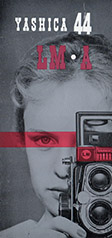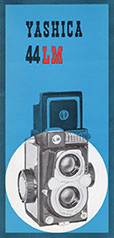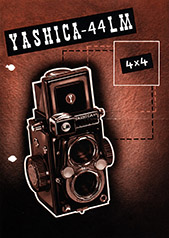44 Models
The 44 era spanned the period from 1958 to 1965.
The same caveats apply as for the 66 models, especially regarding serial numbers.
Contents
(Scroll down or click on links.)
Brochures & Ads
Red Windows
Film Path & Advance
Trim
Focusing Scales
Colours
Yashica 44
Yashica 44A
Yashica 44LM
Yashica Auto 44
Brochures & Ads
Below are links to downloadable PDF files for model specific 44 brochures. These, and 1958 to 1965 brochures which cover the full TLR range, can also be downloaded from the Brochures page.
The first Yashica 44 brochure is in Japanese. The second brochure, almost certainly from early 1958, is annotated “Litho in U.S.A.” and features the Yashica Inc. New York address and US pricing. The image on the front is “actual size” of the first type 44 without accessory shoe, skinny focus knob etc. The third brochure is very similar, close to same, but the image is of the third type Yashica 44 with rear set accessory shoe. This one was printed in Japan. There are minor differences inside. The maker name on the first cover photo is “Yashima Opt. Ind. Co., Ltd.” and “Yashica Co., Ltd.” on the second:
(Brochure 1 scan provided courtesy of Chris Whelan, brochure 2 & 3 scans provided courtesy of Leigh Harris)
Below is a detailed Japanese brochure for the Yashica 44LM which confirms that the 60 mm Yashinon lens is a triplet, a combined Yashica 44LM/44A brochure printed in Sweden in 1960 in Swedish, an English language version of the same brochure printed in Japan, an English language version of a 44LM brochure printed in Japan and a German 44LM brochure (with contradictory lens information, see more in Yashica 44LM, almost certainly produced by the local distributor):
(Brochure 2 scan provided courtesy of Göran Årelind, brochure 3 and 4 scans provided courtesy of Gordon Brown and brochure 5 scan provided courtesy of Leigh Harris)
(Click on any covers above to view PDFs)
Below are a couple of ads scanned by contributor Gordon Brown. The first is a Yashica 44 ad from US Modern Photography magazine believed to have been from 1959. The right ad for the Yashica 44LM and 44A is from an unknown US magazine (the ad features the Yashica Inc. New York address) believed to be from 1960:
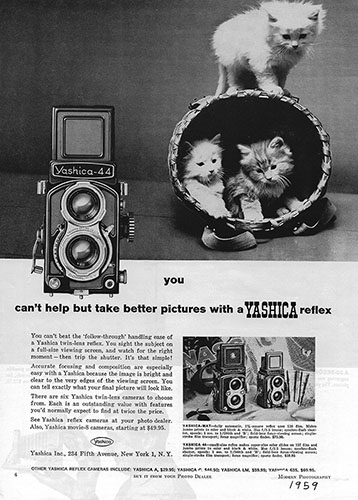
 (Images courtesy of Gordon Brown)
(Images courtesy of Gordon Brown)
(Click on ads to view larger versions)
Red Windows
The Yashica 44A uses a red window for fully manual film advance. The Yashica 44 and Yashica 44LM have semi-automatic film advance and use the red window only to align frame number one. Why not simply use the “Start” mark as with 120 film? All three bodies have start marks cast in (the 44A because it uses the same carcass as the 44) but they are not painted red like on the 66 brethren. I am not familiar enough with 127 film to understand the issues but presumably, the start mark on the films of the day didn't suit these cameras. In fact, most Japanese made 44 models featured a film counter and auto-stop film advance but relied on a red window for setting the start. But with some films, perhaps Japanese Fujifilm, there was apparently no problem.
I can confidently say that Japanese market Yashica 44LMs from release in mid-1959 to about July 1960 have no red windows and no manual reset buttons and use a pin/lever, like contemporary 66 models, to automatically start the frame count when the back is closed. Examples very occasionally turn up elsewhere these days but with metre focusing scales and without the ® mark of export cameras (Charcoal cameras only, the small number of black cameras still have the mark but at least one has Japanese documentation), they are definitely domestic versions (see the Yashica 44LM section for more information).
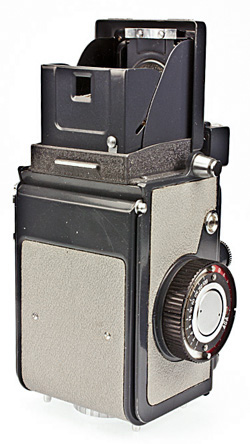 (Image courtesy of Tom Heckhaus)
(Image courtesy of Tom Heckhaus)
Below are typical examples of the grey export versions of the Yashica 44 (Silver Gray early version without accessory shoe and feet focusing scale), Yashica 44A (Charcoal Gray mid-production) and Yashica 44LM (Charcoal Gray late production without the two screws in the back) with back view and closed red window detail:
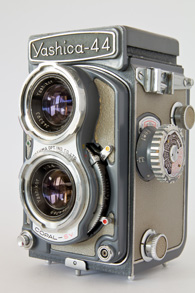
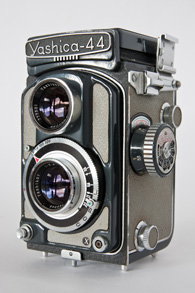
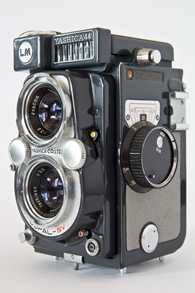
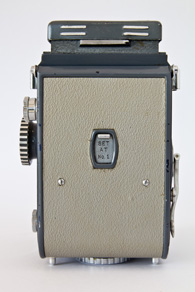
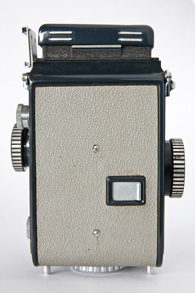
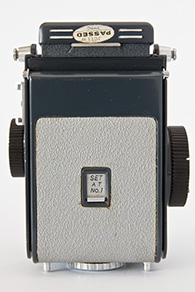
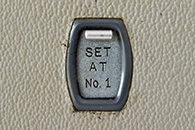
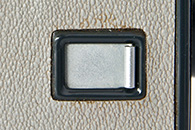
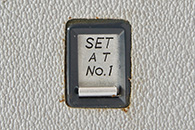
Note that the 44A uses the differently aligned and differently spaced, side row of frame numbers on 127 film for 12 frames of 4 cm x 4 cm. The 44 and 44LM use the first frame only of the centre row of numbers which is actually spaced for 8 frames of 4 cm x 6.5 cm but of course that doesn't matter because subsequent frames are counted automatically. In other words, frame 2 etc wont appear correctly in the window - just in case you were wondering.
Also note how the back of the 44LM sits inside the body just like with the Baby Rollei. Even though there is no similarity from the front like there is with the Yashica 44, this, the strap posts, the angular leatherette inserts in the sides, missing spool knobs and even the DoF scale continue to mimic the Franke & Heidecke design.
Film Path & Advance
Opposite to the 66 models, film is loaded into the top chamber so that it travels flat down past the exposure chamber before turning 90 degrees towards the lower film chamber. This reduces possible problems with film flatness at the time of exposure.
Unlike the film advance on knob wind 66 models where the winding knob is directly linked to the film take up spool, the basic 44A uses gears to place the winding knob in a central position. The 44 contains a similar geared crank mechanism to the Yashica-Mat but there is no interlink to automatically cock the shutter on the back wind. The 44LM operates much as a knob wind 66 model with auto-stop but like the 44A, uses gears to place the winding knob centrally. Because of the placement of the film advance mechanism and knobs/crank, the focus knob on all 44 models is necessarily located on the opposite side.
Trim
The 44 and 44A use the same basic body structure and although the 44LM is heavily revised, they all share many components. The hood is one item. Except for the last 1960 examples in my database, the 44s all had a leatherette centre panel and no logo, the early 44As had the same hoods but with hood logos. The last 44s, late 44As and all 44LMs had an enamelled centre panel instead of leatherette.

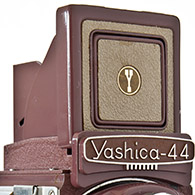
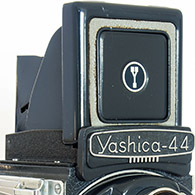
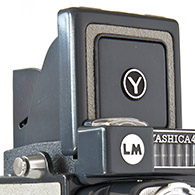
Silver Gray 44, Rose Brown 44A, Charcoal Gray 44A and Charcoal Gray 44LM. These also represent the change in hood logos from none to narrow “Y” gold background to blue background to 1965 wide “Y”.
With the change to the enamelled centre panel came a change to the rear hood blind:
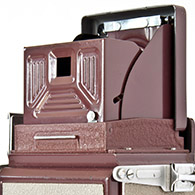
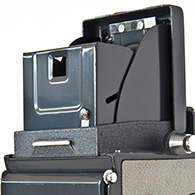
Early Rose Brown 44A on left (same as all 44s except 1960 batch) with leatherette centre panel still, 44LM on right (same as late 44A).
The locking levers and knobs on all models are similar to the 66 Yashica A type but with a fifth “leg” for support:
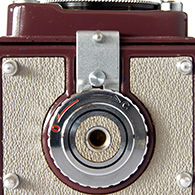
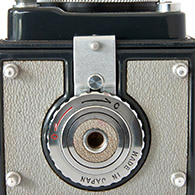
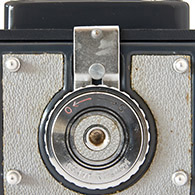
Early Rose Brown 44A on left, mid-series Charcoal Gray 44A in the middle and late 44LM on the right. The 44 and 44A are the same and the 44LM is similar but subtly different with the raised centre spreading out to near the rim and two concentric black rings. “Made in Japan” does not appear on some examples. It is not something that I have tracked but in general, it doesn't appear to be on early 44s and I would say probably not on most except for very late ones. It also doesn't appear on early 44As or 44LMs. The “Made in Japan” on the centre example is engraved (I'm not sure of the actual technique) and painted black whereas on the very late 44LM on the right , as well as late 44A examples, it is coarser and not painted.
Focusing Scales
As with 66 models, the distance scale on the focusing knob was initially either in metres or feet, depending on market. Dual scale knobs were introduced to all 44 models around February/March 1960, including the late batch of 1960 Yashica 44 examples. Domestic versions of the 44LM without the red window may have received the dual scales earlier, or there may have been some retrofitting going on - quite a few examples are affected but by no means all. Initially, the dual scales featured metres in yellow and feet in white. The scales changed to all white in about March 1962.
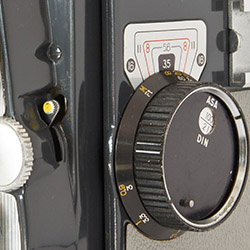 Yellow and white 44LM dual scales.
Yellow and white 44LM dual scales.
Colours
Some websites, particularly sellers, will say that “the grey model was the most popular”. Maybe, but that implies choice. Certainly, grey examples are by far the most numerous. This was the pattern of production according to my database:
- Yashica 44. Whilst light grey cameras were produced throughout the production run, only light grey was available for about the first third of production.
- Yashica 44A. The pattern was reversed. Just over the first half of production contained all the available colours except dark grey cameras. The remaining portion of production only contained dark grey cameras.
- Yashica 44LM. Similar to the 44A, the first half of production contained all the available colours, this time including dark grey which was available throughout. However, the early dark grey cameras seem to be mainly the Japanese domestic market versions without the red window. Black was by far the most popular colour for export versions in this period. The second half of production contained only dark grey cameras.
“Burgundy” and “Rose Brown” Colours
The colour palette is covered in the Yashica 44 section, including the difficulty in telling the two greys of the 44 model apart (the 44A and 44LM have not been found in light grey). One issue not covered is that it is counter-intuitive that the dark brown cameras appear to equate to “Burgundy” whereas the purple-tinged colour of what is on some sites simply called “Rose” has brown in its translated brochure name of “Rose Brown”, or possibly “Rosy Brown”. Or, I may have the names back to front, possibly initially influenced by the “Rose” name that I first found. Whilst neither colour name conjures up a brown camera in our minds, all the research I have done on colour sites suggests that both burgundy and rosy brown colours, in some tones and hues, can approach a dark brown depending on how much blue there is. However, generally, shades of rose brown are lighter than the equivalent burgundy colour. Below are Pantone colour swatches for their burgundy and rose brown - to me, they look like different shades of the same colour:

At the end of the day, the colour names are simply names chosen by Yashica and could mean anything. Unfortunately, I have not found any colour brochures from the period (they probably don't exist). If anyone has a better understanding, please let me know. In the meantime, I'm calling the colour of the brown cameras “Burgundy”.
Yashica 44
Probable release date |
Jun 1958 |
Probable end date |
Sep 1960 |
Lens |
Filter Mounts |
Frame Counter |
Shutter |
|||
Make/Type |
Sync |
S/Timer |
Speeds |
|||
| Yashikor |
Bay 1 |
Hybrid |
Copal SV |
M/X |
Yes |
B,1-1/500 |
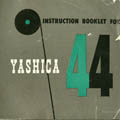 (Click on cover for PDF of full manual)
(Click on cover for PDF of full manual)
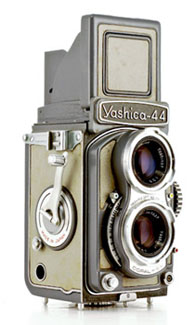
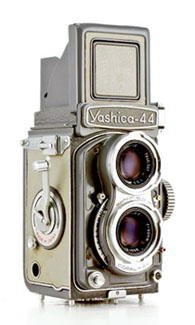
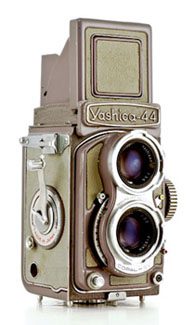
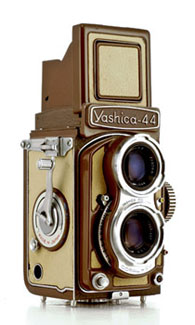

(First four images courtesy of Tom Heckhaus, last image courtesy of Göran Årelind)
The Camera
From the left are first Silver Gray (note the “skinny” focusing knob, different strap holders and no accessory shoe), later Silver Gray (leatherette missing from front, front mounted removable accessory shoe), Lavender, Golden Brown and unadvertised black examples (the last three with rear mounted fixed accessory shoes, see below for colour details). Missing here, but discussed and shown further down is the final type with enamel instead of leatherette on the centre panel and blue narrow “Y” hood logo. Below is a rare Burgundy example.
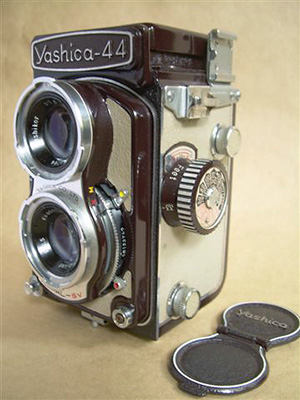 (Image courtesy of Leigh Harris)
(Image courtesy of Leigh Harris)
Released in 1958 in response to the grey “Baby Rollei” (see “Yashica 44 Series” for the full story). Yashica 44s are fitted with 60 mm f/3.5 Yashikor lenses and Copal SV shutters. Unlike the crank wind 66 models, the crank wind is not coupled to the shutter and also when loading film, the film has to be first advanced to the number 1 frame position using the red window on the back. Then the counter reset button has to be operated (by 1957, the counter reset button had disappeared from the 66 models). After that, a half rotation of the crank advances the film and the number in the counter window.
Late Examples
Production is thought to have ceased around the middle of 1959 when both the Yashica 44A and 44LM appeared. However there is a bunch of nine cameras with serial numbers 650xxx and 69xxxx (only six with actual body numbers, the others are interpolated to fit into this group by lens numbers and trim). Reference to my Serial Numbers page implies that series production did cease around September 1959 but then these were produced between, or in, May and September 1960. Whilst that may seem a bit outside of the production timeline, the nine do have the later blue hood logos that didn't come to the Yashica 44A and 44LM until August 1959 (by serial numbers) and the 44LM style focusing hood which didn't come to the 44A until February 1960. The nine also are the only Yashica 44 examples with dual scale focusing knobs, something which wasn't introduced to the other two models until a fair way into their production runs, again February 1960 according to serial numbers. The earliest of the nine is Silver Gray (not the example further below), the rest Charcoal Gray.
Charcoal Gray example owned by correspondent Carl Garner:
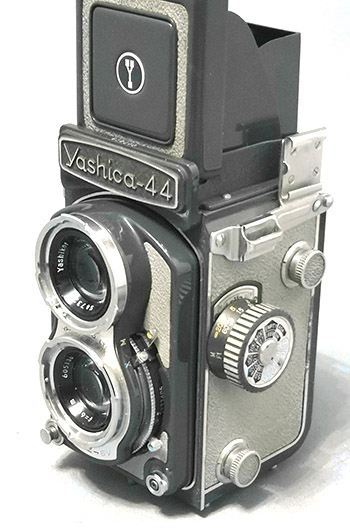
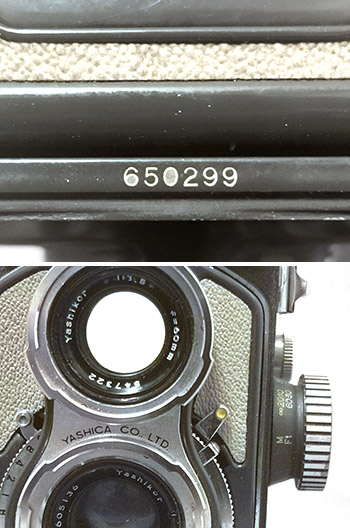
(Images courtesy of Carl Garner)
Below and further down in one of the group photos is what looks like a Silver Gray version but only the focusing hood belongs to 1960 and perhaps also the third type strap holders/rear set accessory shoe, the rest is the earliest version from 1958:
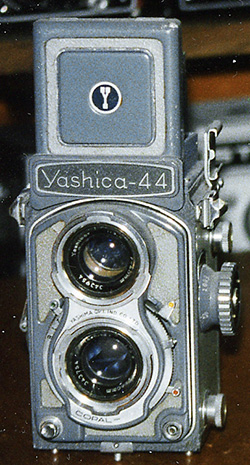 (Image courtesy of Tom Heckhaus)
(Image courtesy of Tom Heckhaus)
Amazingly, this same camera has appeared in a 2025 auction (confirmed by taking lens numbers) and I can confirm that the body serial number is 23056 and the lens numbers are 343754 (taking) and 343954 (viewing), all early 1958. The skinny first type focusing knob with scale in feet and “Yashima Opt. Ind. Co., Ltd.” between the lenses are in character with that period. As there are no Silver Gray (light grey) Yashica 44A or 44LM examples, the hood is almost certainly from a 1960 44 model.
Colour Palette
An ad from a 1958 edition of Japanese monthly magazine Asahi Camera and two 1958 Yashica brochures trumpet the availability of seven colour combinations in “Symphonic Color”:

(Image courtesy of Leigh Harris)
Thanks to Tom Heckhaus, the colours have been translated below. There is an article in a “Vintage Viewfinder” publication “did'ja ever wonder” column from some years ago which confirms the translations (but calls “Rose Brown” instead “Rosy Brown”) and suggests that the range of colours was offered by Yashica following market research that showed that the grey of the Baby Rollei appealed to women in particular. The table lists the translated names with my interpretation of metalwork and leatherette descriptions commonly found on the web in the other two columns:
No. |
Camera Colour |
Metalwork Colour |
Leatherette Colour |
1 |
Charcoal Gray | dark grey | light grey |
2 |
Silver Gray | grey | light grey |
3 |
Pastel Blue | blue | light grey |
4 |
Lavender | lavender | light grey |
5 |
Golden Brown | light brown | dark cream |
6 |
Rose Brown | rose | light grey |
7 |
Burgundy | dark brown | warm grey |
There is also an additional eighth, unadvertised colour (perhaps because it was not available in Japan?):
8 |
black | black | light grey |
I have to admit that I struggle with identifying the colours correctly. The colour balance and tonality of many of the low resolution JPEGs found on the web leaves something to be desired and there is not enough image data left to make adjustments. I particularly find it hard to separate the two greys in some photos.
There are 10 black cameras in my database, mainly from Europe. One is owned by contributor, Göran Årelind (see above). Where the nameplate area is visible, the cameras feature the ® mark of export cameras. Most have have focusing scales in metres and the tenth is dual scale, therefore these could be European export versions. Another example is shown below in the US based “Somebody's Collection” (not in my database) which has a focusing scale in feet (clear in a different photo).
According to the translation of the Yashica colours, this is a Lavender Yashica 44 (based on a magazine article, Tom Heckhaus has always known it as “dusty rose”):
 (Image courtesy of Tom Heckhaus)
(Image courtesy of Tom Heckhaus)
Here it is again next to what I believe is a Rose Brown Yashica 44A (I have photos of Yashica 44s in a similar colour and also see below):
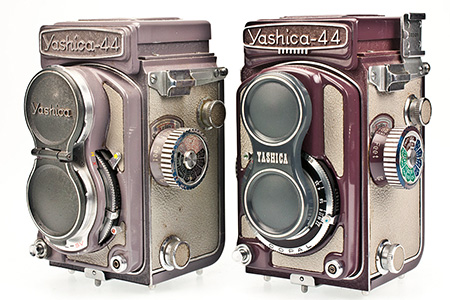 (Image courtesy of Tom Heckhaus)
(Image courtesy of Tom Heckhaus)
Note, by its lens serial numbers and strap holders, the camera on the left would be expected to have a removable accessory shoe but there is no provision in the side of the nameplate - the nameplate and serial number appear to be from a later camera which would have had a rear mounted shoe (in this photo, both examples are fitted with lens caps that belong to grey examples, the lavender lens cap in the first photo above is a later acquisition).
The leatherette colour is perhaps the hardest to confirm. With aging and reflections off the metalwork plus surroundings, the difference between light grey and what I thought might be cream is marginal in most photos. In regard to the leatherette colour on Burgundy cameras, Leigh advises that “it is definitely not beige, but a 'warm grey' is the best way I can describe it, and the difference is really only noticeable when the cameras are side by side” (with the grey cameras). Leigh's Burgundy Yashica 44 is above and he also has a Burgundy A III and several grey cameras to compare (see also Coloured 66 Cameras). I have since seen Leigh's cameras and agree with his assessment of the colour difference but to me, “warm grey” could just as easily be called “light beige” or “light grey brown”.
The first third of my Yashica 44 database of 239 examples and about two thirds of of my database overall are grey with light grey leatherette covering and mid grey metalwork, i.e. Silver Gray. The first “coloured” camera is Golden Brown (12 examples) followed by, Rose Brown (5), Burgundy (6), Pastel Blue (7), Lavender (6), black (6) and Charcoal Gray (21). These are all interspersed with Silver Gray in the second two thirds of the database (as noted earlier, the last 44 examples in my database are 8 Charcoal Gray cameras from 1960).
Somebody's Collection
Tom Heckhaus has sent me photos of somebody else's collection taken in the pre-digital days of 1999. The collection was broken up and some of the 66 models have appeared on auction sites and were already in my database, but none of the 44 cameras were. Until 2025. In an amazing coincidence, contributor Chris Whelan pointed me to an auction featuring three 44 and three 44A models. From lens numbers, I can confirm that the light grey and Golden Brown (last photo) 44 cameras and most likely the Pastel Blue are in both collections. The photos themselves look pretty good and accurate for colour but after scanning and display on all sorts of monitors, most probably not calibrated, don't expect miracles. The cameras themselves are a fraction over-exposed and both the light grey camera (top left in the first photo) and dark grey camera (bottom right in the second photo) look too blue on my calibrated monitor. Note that the light grey camera in the top photo has the later focusing hood of the last of the Yashica 44s but as noted in Late Examples above, it is a parts special and has the earliest body of the cameras displayed.



(Images courtesy of Tom Heckhaus)
Accessory Shoes & Other Trim
There were three different arrangements with accessory shoes and two styles each of strap holders and focusing knobs. Approximately the first third of cameras in my database have no accessory shoe:

Notice also the “skinny” focusing knob and the strap holders with the vertical slot arrangement.
Next, the focusing knob received wider and finer knurling (see Golden Brown example further below) and the later type strap holders similar to those fitted to the 44A (except for the integrated accessory shoe). There are only four cameras like this in my database before the first accessory shoe arrived. This is front mounted and removable, note the nameplate slot highlighted in yellow, and features on the middle third of Yashica 44 production:
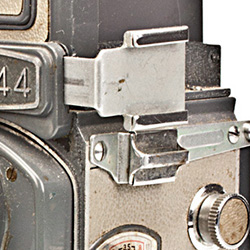
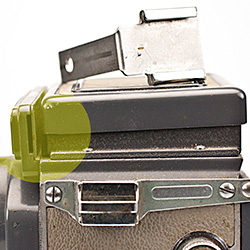
(Images courtesy of Tom Heckhaus)
The last third of the Yashica 44s in my database have rear mounted accessory shoes the same as the Yashica 44A model:
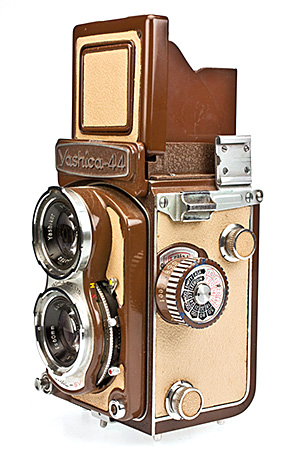
(Image courtesy of Tom Heckhaus)
Golden Brown example.
The 1960 production with dual scale focusing knob and 44LM style focusing hood is covered in Late Examples above.
Trim Changes - By Serial Number
The first cameras in my database are in the serial number range 17xxx to 22xxx. They are all Silver Gray. These cameras have no accessory shoe or hood logo but the hood centre panel, as with nearly all Yashica 44s except for the very last few, is covered in leatherette. The focusing knob is more waisted than on later cameras, the knurled wheel is thinner and the knurling appears coarser. The focus scales are still only in feet. Strap holders on the first cameras have a unique vertical slot strap attachment arrangement. The company name between the lenses is “Yashima Opt. Ind. Co., Ltd.”
Camera 5850xxx with taking lens 347xxx is the start of a new series of cameras with 7 digit serial numbers. Only a few cameras later is the first example with metre focusing scale. This was for sale in Sweden and remains the only one until coloured cameras started arriving. Clearly, in the beginning, this model was export only.
Next was a trim change with camera 5851xxx introducing the later type focusing knob and new strap holders with loop strap attachment arrangements that carry through to the Yashica 44A. There are four cameras in my database like this until 5866xxx added removable accessory shoes as well.
There may be 12 cameras with 5885xxx numbers. By 5885xxx, taking lens 419xxx, two Lavender, a Rose Brown and a black camera have appeared but most are still Silver Gray. Focusing scales in metres became more common, both with the ® mark (European export) and without it (domestic consumption). Somewhere between camera 5890xxx (the earliest Burgundy example) with taking lens number 425xxx and camera 3890xxx with taking lens 428xxx, the body serial numbers change from a 58 prefix to a 38 prefix. Similar changes occurred with Yashica As and Ds and other models at probably about the same time and are “explained” on the Serial Numbers page. Also, within the first 150 of 3890xxx serial numbers, the company name between the lenses changed to “Yashica Co., Ltd.”
Between 7 digit camera 3895xxx and new 8 digit camera 38101xxx (translated to mean between September and October 1958), on camera with lens number 372xxx, the strap holders changed to the third type. These were the same as the second type but with an integral accessory shoe mount at the rear of the camera on the focusing knob side. After 38115xxx (November 1958) is a new series of 7 digit numbers, starting with 3911xxx (January 1959). These run through to 3990xxxx (September 1959) with lenses in the 384xxx to 387xxx, 454xxx to 491xxx and 601xxx to 604xxx ranges.
The next nine cameras are the afore-mentioned examples with new six digit body serial numbers in both 650xxx and 690xxx serial number ranges (May and September 1960, body numbers discernible on only six). Lens numbers are in the 605xxx, 492xxx and 547xxx to 554xxx ranges (in that order of appearance, 605xxx and 492xxx are from 1959 lens series probably using up existing stock on the first few examples, 547xxx to 554xxx is a new 1960 series with the 44A and 44LM also using those lens numbers for similar months). They all have dual scale focusing and Yashica 44LM style focusing hoods. As far as I can tell, the first of the nine 44s is Silver Gray, the others are Charcoal Gray.
Lens Caps & Ever-ready Cases
(See also Lens Caps, Cases & Boxes page.)
Lens caps are hinged cast alloy, similar to, but smaller than, the 66 Bay 1 lens caps from the same period. I have found matching Silver Gray, Charcoal Gray, Lavender, Burgundy, Rose Brown and Golden Brown examples. Camera cases are commonly grey but I have found five black cases; two with Lavender cameras, one with a Rose Brown camera, one with a Burgundy camera (it should be noted that the other coloured Yashica 44s in my database did not have cases) and the fourth with a Silver Gray camera.
Yashica 44A
Probable release date |
Apr 1959 |
Probable end date |
Jun 1965 |
Lens |
Filter Mounts |
Frame Counter |
Shutter |
|||
Make/Type |
Sync |
S/Timer |
Speeds |
|||
| Yashikor |
28.5 mm |
Red Window |
Copal |
X |
No |
B,1/25-1/300 |
(Click on cover for PDF of full manual provided courtesy of Göran Årelind)
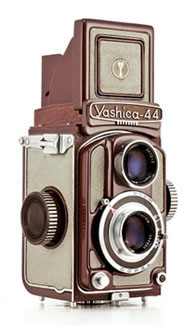
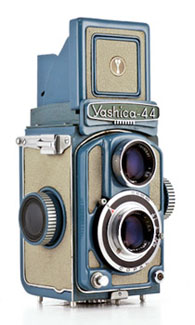
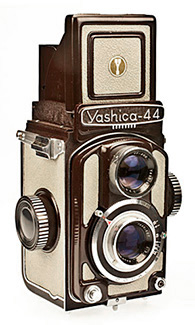
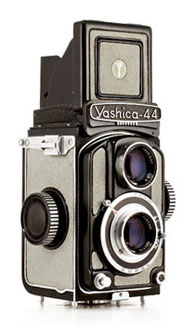
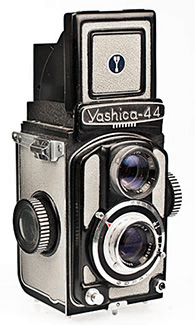
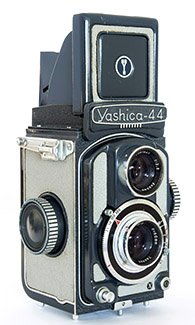
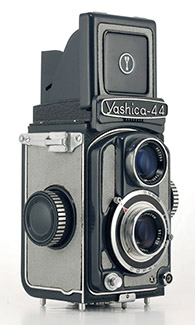 (Images 1 to 5 & 7 courtesy of Tom Heckhaus)
(Images 1 to 5 & 7 courtesy of Tom Heckhaus)
The Camera
In order of timeline appearance in the database, from the left are Rose Brown, Pastel Blue, Burgundy, black with earlier gold hood logo, black with later blue background hood logo, earlier Charcoal Gray with shiny “teeth” (see more below) and final type Charcoal Gray examples. Note that the odd Pastel Blue and early black example are found with blue logos - they appeared first on these colours but sparsely and seemingly randomly. Most examples up to the general changeover in August 1959 are still gold (there is more here in the 44LM section).
It is easy to believe that the Burgundy (brown) 44A is fairly rare, but thirteen have been found so far. You just have to know where to look. Most of the examples in my database are from either Sweden or the Netherlands and on all eleven where the focusing scales are visible, the focusing scales are in metres, including on two found in the US. The Burgundy cameras fit in the middle of the database, just before the black series of cameras.
Probably released in earlyish 1959, this was a simplified version of the Yashica 44. The crank wind was replaced by knob wind and fully manual film spacing by the red window as with the Yashica A and its budget forbearers. However, unlike those, the film travels top to bottom and the winding knob connects to the bottom spool via gears. The Copal shutter, X sync only, was from the Yashica A as well and although the Yashica 44 lenses were unchanged, the Bay 1 filter mounts were replaced by plain mounts. The two nameplates are both very similar and say “Yashica-44” on the front. The 44A nameplate has a series of 8 short, vertical bars under the name. These are sometimes referred to as “teeth”.
On all the early cameras with colours other than Charcoal Gray and also all Charcoal Gray ones with pressure plate screws still visible, the teeth are shiny, milled even with the nameplate surround. On late grey cameras without the screws in the back, the teeth are recessed slightly and painted:
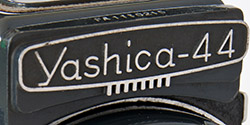
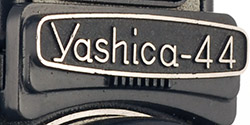
(Right image courtesy of Tom Heckhaus)
Oddly perhaps, the two pressure plate screws in the back are arranged in a vertical manner whereas on all other Yashica TLRs they are in a horizontal line. The reason is that the 44A has an offset red window which uses the 4 x 4 frame counting numbers on the edge of 127 film - see the “Red Windows” discussion at the top of the page. In other respects, the cameras are essentially the same, except for some minor trim changes and colour palette. The Sears catalogue from around 1959 lists the Yashica 44 at US$61.50 and the 44A at US$35.50, a considerable saving and it wasn't long before it was generally advertised at US$29.99.
Some websites have comments such as “many of the Yashica 44As have the letter A on the nameplate”. They do, on the top edge, not far from the serial number but still a gap more than serial number prefixes have.

Also the pattern of numbers is the same as other cameras of the period without prefixes. It has a full stop after it, unlike serial number prefixes and is also appreciably larger than the serial number characters. I used to believe that the “A” should be part of the serial number but I no longer do. Some people may say that “although the prefix style and numbering system is different to when Yashica introduced that across the board in about 1961, the Yashica 44A system is the first iteration of introducing a prefix.” That still remains a possibility. I have copies of two Yashica 44A “Certificate of Guarantee” documents completed by two separate US retailers. The one completed in December 1959 does not include the “A”, the other filled out in April 1961 (probably 1960 stock, prefixed numbers started at the beginning of 1961) does include the “A”. When the serial number prefix “FA” appears, the “A”s disappear.
There are also claims that some examples had an “A” on the front of the nameplate. McKeown (1992-1993 edition) shows a rendition of one such 44A. It has a gold logo which puts it at the beginning of the 44A series. I have yet to see one. It may also be the case that Yashica made early publicity material available and the nameplate was changed on production versions.
Note, the ® mark shown is a registered trade mark sign and not part of the serial number. There is more on the mark here.
Until dual scaled focusing knobs arrived more than half way through the database (about March 1960), except for the Burgundy Yashica 44As in the middle of this period and one Black camera towards the end of this period, all have scales marked in feet. German and UK sites often seem to have black 44As for sale so the Black example may be European as well. The ® mark seemed to appear on all Yashica 44A examples, including those with metre focusing scales, until about February 1960 when the practice stopped with camera 620xxx. On a number of other models with the ® mark, at least some examples with metre focusing scales didn't have the mark, suggesting that these were for domestic consumption. On the evidence available, it seems that the 44A may not have been sold in Japan, at least in the period from its release in 1959 until early 1960. That would fit fit with Sugiyama's claim that the model was released in 1960 because in Japan, it probably was.
Colours
Unfortunately, I have not been able to find a definitive colour palette description but below are the colours I have found in order of appearance in the database. I believe that they are a subset of the Yashica 44 colours with the least popular ones dropped and the Silver Grey dropped because of the litigation brought by Franke & Heidecke:
No. |
Camera Colour |
Metalwork Colour |
Leatherette Colour |
1 |
Rose Brown | rose | light grey |
2 |
Pastel Blue | blue | light grey |
3 |
Burgundy | dark brown | warm grey |
4 |
black | black | light grey |
5 |
Charcoal Gray | dark grey | light grey |
The Yashica 44As have an extra colour variable. The end caps of the film winding knobs are black on black cameras and grey on grey cameras. Rose Brown cameras (earlier than black and grey examples) have grey caps but some look black. Maybe its just the effect of aging and/or the quality of photos. Burgundy cameras have grey caps. However, the earliest Pastel Blue cameras have blue caps but later ones have grey.
The pattern of colours found is reversed to the Yashica 44; the “coloured” cameras are the only ones in the first part of my database (37 Rose Brown, 19 Pastel Blue, 8 Black and 13 Burgundy). After the Burgundy cameras, the next group are Black cameras only (74) and the last (most recent) are Charcoal Gray examples only (122). My theory is that as the coloured Yashica 44s were introduced, they proved very popular as a differentiator at the height of the super slide boom and the coloured 44As were released to take advantage of this. As the boom died off, costs and hence variation, had to be reduced and perhaps serious photographers remaining in the 44 market had a more conservative demeanour. Why black before grey? Perhaps Yashica was still smarting from its court case on one hand and then finally trying to re-capture some of the popularity of its version of the “baby grey” as a last hurrah. The Charcoal Gray of the Yashica 44A and 44LM when finally released (at probably near the same time) was much darker than the Silver Gray that had caused problems with Franke & Heidecke. Coincidentally, around May 1963, the “Baby Rollei” changed from only being available in light grey to only being offered in black (RolleiClub). Whether there was any connection between the two events is anybody's guess.
There was one other variation with the Yashica 44. The Rose Brown, Pastel Blue and Burgundy cameras have a focusing knob with film reminders in three colours; red brown for the scale description, blue for the slow ASA/ DIN numbers and green for the high speed numbers (there are two exceptions where the blue and green are reversed – see later). Yashica 44s and Black and Charcoal Grey Yashica 44As used the same monochromatic style (actually, descriptions and high speed values in black reversed on silver and low speed values in a red brown).
Production
According to my database, production seems to have gotten under way in April 1959 and continued until November 1963. There was nothing at all in 1964 but then production seems to have restarted in February 1965 and then continued until July 1965. Fourteen months is a very long gap without a single camera turning up, unless production was extremely low in the period. Either way, still odd. On the Brochures page are circa 1964 TLR brochures (although, admittedly, early 1965 is also possible) which include the 44LM but not the 44A. However, there is also a Belgian brochure with 1965 on the cover which does list both models. So whilst the brochures are a bit rubbery time wise, they at least don't contradict the idea of a production gap year. Perhaps there was an inventory problem, change of mind or spare production capacity became available.
Trim Changes - By Serial Number
The first 44A in my database is Rose Brown. Typically at this point, this has the word “Japan” in the middle of the accessory shoe located at the rear of the camera (only the addition of the word is different to the later Yashica 44s). It still has the original Yashica 44 type focusing hood with leatherette central panel and the rear of the hood blind has the three panel strengthening pressing. The only change is the addition of the narrow “Y” hood logo on gold background. It has taking lens serial number 349xxx. The first with body serial number in my database is 3940xxx, some 5 cameras later, and the last in this series of seventy seven cameras is 3993xxx. Lens numbers are typically in the range 388xxx to 399xxx and 460xxx to 498xxx.
After the first Rose Brown example, there are another three followed by four Pastel Blue examples. The last of these, 3940xxx with taking lens 388xxx, is the last Pastel Blue camera with a blue end cap on the film winding knob. A group of nine Rose Brown cameras follows culminating in 3941xxx. Then there is an early group of five black cameras from 3942xxx to 3950xxx. Although other colours still have the film speed reminder scales in blue, green and red, this black group reverts to the monochromatic style of the Yashica 44 and later Yashica 44A examples. Strangely, two of the five have blue logos instead of gold even though blue logos don't appear until somewhat later. I'm not quite sure of what to make of that, although it is near the time that blue logos first appeared on the last of the Yashica 44s.
These are followed by eight Pastel Blue cameras, the first of which also has a blue logo. This is the last for what I calculate is another 3 months of production with gold logos. Camera 3952xxx, on the right below, is the third last Pastel Blue camera in my database. It is very unusual because as noted earlier, the blue and green background colours of the film speed reminder scales are reversed.
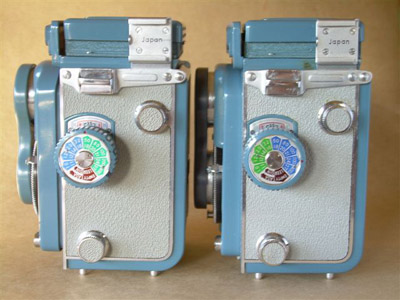
(Image courtesy of Leigh Harris)
It is only one of two examples. The second is a burgundy example approximately 1,000 cameras later.
Then there is a final block of 15 Rose Brown cameras and 3953xxx is the last one. Following are thirteen Burgundy examples in one block with serial numbers 3960xxx to 3961xxx. All focusing scales are in metres on the eleven examples where the scales are visible (although a correspondent claims that he has a feet scaled one). These Burgundy cameras and one black one are the only ones that don't have scales in feet or dual scales. The film speed reminder scales on these and the previous rose cameras are “normal” relative to the renegade blue example.
Camera 3970xxx is the start of the big second block of 49 black cameras. The only trim change is that the focusing knob scales revert to the earlier monochromatic style of the Yashica 44. At around 3982xxx, the gold hood logo changed to a blue background. The numbering series comes to an end with 3993xxx and a new series starts with 4100xxx and lens number 507xxx. The block of sixteen cameras ends with 4112xxx with lens 516xxx which is the black camera with a with metre scale focusing knob. There is one more black camera with taking lens number only, 527xxx. This is the first 44A with dual feet/ metre focusing scale.
With the change to dark grey livery, there is a change to six digit numbers. 620xxx to 622xxx revert to feet focusing scales but have the new hoods with the enamelled centre panel in place of leatherette and the single panel strengthening pressing of the rear of the hood blind. Also, the word “Japan” is dropped from the accessory shoe. 650xxx is the last in this series.
FA 1020xxx is the first of 71 cameras with the FA prefixed block of numbers which run out to FA 3111xxxx. As with other similar Yashica numbers, no second digit from the left is greater than “1”, or more correctly, the second and third digits from the left, together, are never more than “12”. The next camera, FA 1040xxx, introduces the small “X” next to the flash sync socket on the front. From FA 2090xxxx, the external pressure plate screws disappear from the back and the “teeth” lose their shine and are painted.
As noted earlier, there are no examples in my database from any month in 1964, meaning no FA 401xxxx to FA 412xxxx numbers. In fact after November 1963, the last eight Yashica 44As in the database are from February to July 1965, serial numbers FA 5020xxx to FA 5070xxx with taking lens numbers 295xxx to 338xxx and possibly 34xxxx.
Lens Caps & Ever-ready Cases
(See also Lens Caps, Cases & Boxes page.)
Lens caps are hard plastic push-on and match the colour of the metalwork of the cameras.
Cases are either grey or brown. Brown replaced grey in about 1961 at or near the time that serial numbers with the “FA” prefix were introduced so that the grey later cameras almost invariably have brown cases. Most catalogues of the time indicate that cases were sold as an extra for these models, but from the database pattern, it is unlikely that there was any choice regarding colour. The odd exception is explained by items being bought separately over the last 50 years including, e.g., buying a new case in 1962 for a 1960 camera.
The last three 44A cameras with cases, FA 5040xxx to FA 5060xxx, have a new case logo also found on late 44LM and contemporary 66 cases (shiny raised gold on a creamy white enamel background):
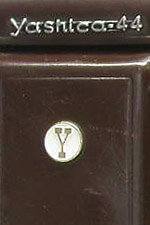 (Detail from larger web image)
(Detail from larger web image)
Yashica 44LM
Probable release date |
Jun 1959 |
Probable end date |
Jul 1965 |
Lens |
Filter Mounts |
Frame Counter |
Shutter |
|||
Make/Type |
Sync |
S/Timer |
Speeds |
|||
| Yashinon |
Bay 1 |
Hybrid/ Counter |
Copal SV |
M/X |
Yes |
B,1-1/500 |
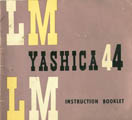 (Click on cover for PDF of full manual)
(Click on cover for PDF of full manual)
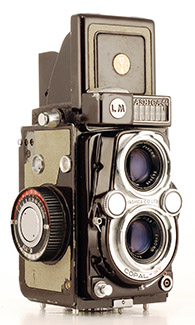
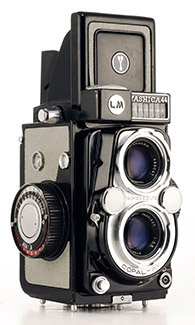
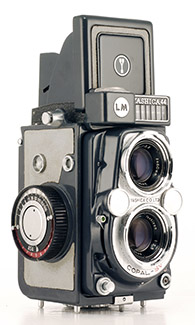
.jpg)
(First three images courtesy of Tom Heckhaus)
The Camera
In order of timeline appearance in the database, from the left are Burgundy (control wheel centre trim has been replaced from Yashica 24, 12 or Mat-124), black, Charcoal Gray and Charcoal Gray with new hood logo examples. Note, early black cameras were the first to receive the blue hood logo but a few later ones have gold logos before blue became universal - more here. Like Burgundy examples, early Charcoal Gray cameras have gold logos. Note, I now know that the last camera with the wide “Y” hood logo is an earlier camera, probably from 1961, with replaced meter and focusing hood. From this angle, the only difference to a genuine late model are the control wheels which are dull instead of shiny (not obvious from the photo). More details in “Late Example?” further below.
I doubt that the 44A had been long on the market before the 44LM was released, probably in mid 1959 (see “Yashica 44 Series”). This is the best specified 44 (apart from its mythical sibling, the Auto 44). Although it used the same hood as the later examples of the Yashica 44A, i.e. enamelled centre panel etc, and the Copal SV shutter from the Yashica 44, many of the other parts, including the carcass, are different. This includes post-like strap attachments attached directly to integrally cast lugs on the side panels. Lenses were upgraded to f/3.5 60 mm Yashinons - see below. Although film wind-on is by the simpler geared knob and central release button, it has the advantage over the uncoupled Yashica 44 crank system of incorporating adjustable exposure scales for the uncoupled selenium cell exposure or light meter, hence the “LM”. Shutter speeds and aperture are set by control wheel as with e.g. the Yashica D and Yashica-Mat. Light baffles to reduce internal reflections and flare are rarely seen on Yashica Cameras but the 44LM introduces them to the 44 series. They are tiny and only fitted to the top and bottom - there is not much space in there. Bottom baffle visible on left side of image. See the images for the 44LM without red window below for the top baffles.
.jpg)
Note also the unpainted start marks compared to the camera below.
The 1959 price of this camera was a little higher than the original Yashica 44 (14,500 yen compared to 11,800 yen in a 1959 Japanese brochure) but the “upgraded lenses”, control wheels and exposure meter made it seem better value for money. Also, 14,500 yen was for the domestic model without red window and the automatic film counter reset. The export versions with red window film start and manual reset may have reversed the price difference - the 1959 Sears catalogue lists the 44 at US$68.88 and the 1961 catalogue lists the 44LM at US$59.99. It is not a pretty camera like the other two but to me at least, it is far more attractive in the flesh than photos suggest.
Thirty eight cameras have been identified with either a feet or metre scaled focusing knob of which sixteen cameras have a metre scale knob. At least thirteen of the sixteen are Japanese market only versions with no red window (see below).
60 mm Yashinon Lenses
I am sorry to disappoint any owners who believe that their camera features 4 element Tessar lenses but Yashica 44LM Yashinons are triplets. 100% correct. That puts an end to almost 60 years of folklore. A very detailed 1959 Japanese Yashica 44LM brochure, unequivocally states (Google translation) “Yashika (sic) 44LM lens, Yashinon is a triplet type high reputation lens...”. Alongside is an image of a triplet schematic:

With the exception of one German brochure which appears to be published by the local distributor, I have never seen an official Yashica ad or a brochure which claims that the 44LM has a 4 element lens. What is not known is whether 3 element Yashinons are an improvement over 3 element Yashikors. Yashica implies on the same page that a “good lens” will deal with aberrations better and that coatings may be more complex, however, what is not clear is whether the “good lens” is a 3 element Yashinon and whether it is being compared to a Yashikor or whether it is just a statement about the lenses Yashica use.
See also “Are all Yashinon Lenses 4 Element Tessar Types?” which attempts to answer the question through carrying out tests based on the well known use of reflections and comes up with the same answer. “Putting 3 Element Yashinon Taking Lenses into Context” attempts to explain the apparent “deception” by taking a pragmatic look at Yashica's circumstances in the late 1950s, early 1960s.
Red Window and Missing Red Window
The red window on the Yashica 44LM is used for winding on the first frame, then the reset button is operated. From that point forward, the frame counter on the side of the camera keeps track of exposures. To advance to the next frame, the centre of the winding knob is depressed and the knob turned until it stops. The shutter is still cocked separately and there is no double exposure prevention.
This system is similar to the the pre-War Rolleiflex and Rolleicord models with film counters and the red window on the camera base. In 1954, the Yashica Flex S introduced a later Rolleicord based system for Yashica 66 models which used a pair of cast start marks in the back against which the start marks on 120 film were aligned. On the 66 models, the reset button was soon replaced by a spring loaded pin, or lever. After the film is set to the start mark, the reset is automatically performed when the back is closed, forcing the pin or lever back into the body. The 44s needed to retain the reset button as the back was already closed as the first number was reached in the red window.
As noted at the top of this page, some Yashica 44LMs have turned up without the red window. These also don't have a reset button, instead using the automatic system of the 66 cameras. They have been predominantly found on Japanese sites and seem to encompass all domestic examples produced from release in mid-1959 to about July 1960. All 44LMs have start marks cast in but usually, they are not painted red as in cameras where they are intended to be used (see image in previous section). Presumably, the reason for the red windows on the Yashica 44 and 44LM is that there was a problem of some sort with the corresponding start marks, or maybe lack of them, printed on 127 film at the time. Post-War 127 cameras were generally basic affairs, with manual film advance via red window and the first sophisticated 4x4 TLR was the 1957 Baby Rollei which was fitted with a more advanced film counter system and didn't need to use red windows or start marks. Other Japanese 44 cameras such as the Primo-Jr/ Sawyer's Mk IV, Minolta Miniflex and various Tougodo models used the same red window start based system as Yashica.
I am guessing that some Japanese companies such as Fuji Photo Film Co., Ltd. (“Fujifilm”) and/or Konishiroku, the modern day Konica, (“Sakura”) may have come to the party with adapting their 127 film to 44 TLR needs. As Japanese film companies effectively enjoyed a monopoly in the Japanese market at the the time, Yashica probably felt that there were opportunities to sell the Yashica 44LM in its home market as originally designed.
In my innocence I say that nothing needed to be added, except for some red paint for the cast start marks, it was simply a matter of deleting the windows. The replacement of the reset button was probably done because the technology was proven and the mechanism was unlikely to be any more complicated than the external button. The film counter would require a lead-in starting with “S” at the start point rather than simply “1” at the first frame position (in other words, even with a correctly marked film, it would not be possible to use the start marks in an example with the red window). However, in reality, there may have been a cost. As noted earlier, the Japanese market 44LM was more expensive than the earlier 44 but export versions seemed to reverse that.
The reason that Yashica seems to have ceased production of this version in mid-1960 may be related to getting the Japanese price down and/or to cut the cost of producing two versions. Or maybe there was an issue with the film. Or some other unknown reason.
Of the fifty 44LMs without red windows in my database, one is from the Netherlands, two are from the US (one with both English and Japanese user manuals), two are from the UK (known to be bought in Japan in the early 1960s) and the rest are from Japanese sites. All, except four earlyish black examples, are Charcoal Gray cameras amongst mainly Burgundy and black cameras and except for the last five examples, from before the time that production changed to Charcoal Gray cameras only. The earlier examples have metre focusing scales, later ones have dual scales. The ® mark is discussed elsewhere. In the period that the mark was in use, most Yashica 44LMs seem to have it including those with focusing scales in metres, except for all the Charcoal examples without the red window. That strongly indicates that they were intended for domestic Japanese sale only. Strangely, the four black cameras retain the ® mark even though I think all were for sale in Japan, one with its boxes and Japanese user manual and other documentation. Perhaps the mark was pre-stamped and the the small number of black cameras didn't warrant a production change?
The earliest camera is 3950xxx (May 1959) which is the first production 44LM in my database. The next cameras have serial numbers between 3960xxx and 3984xxx (August 1959) and then from 39100xxx to 39101xxx (October 1959). The last genuine example has serial number 650xxx (May 1960) and a dual scale focusing knob. There is also 670xxx but it has a focusing scale in meters and possibly earlier lens numbers. It may be like two later examples which have almost certainly had their meters replaced. FL 1120xxx has early features and by lens numbers, is the second earliest of the examples and FL 3070xxx seems to fit between 3980xxx and 3981xxx.
Two black cameras both have serial numbers 3964xxx (June 1959) and the third is 3984xxx (August 1959). All have blue background hood logos. In that regard, the earlier two are like other early black examples - Charcoal and Burgundy cameras and also some later black cameras still have gold logos. Japanese domestic cameras do not usually exhibit the ® mark but these three do (all are from Japanese auctions).
The camera below is the one sold on the Netherlands site. In a feat of international cooperation by the Yashica TLR community, I first identified the camera and it was bought by Swedish contributor, Göran Årelind, on behalf of US collector Tom Heckhaus!
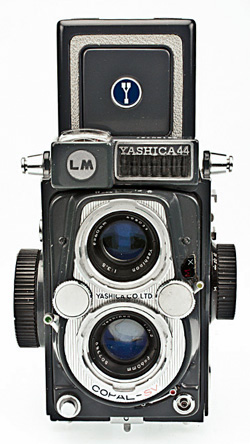
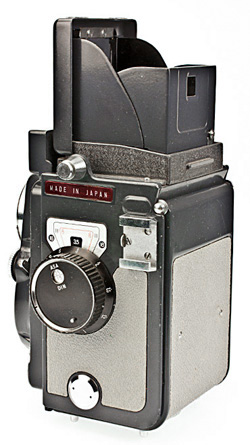

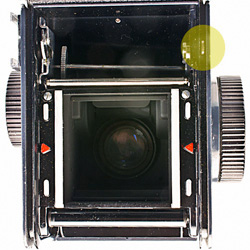
(Images courtesy of Tom Heckhaus)
Note the red painted start marks and that there is no film counter reset button on the side as with other 44LMs with the red window. Tom has highlighted the reset switch lever in the back of the body with the yellow highlight circle. (Note also the top light baffles common to all 44LMs but not visible in the photo further up the page.)
Below is a page from a 1959 Japanese language brochure.

Colours
Again, no formal colour palette has been discovered but the following are the colours found. Again, I am assuming the three colours are a subset of the original seven plus one of the Yashica 44:
No. |
Camera Colour |
Metalwork Colour |
Leatherette Colour |
1 |
Burgundy | dark brown | warm grey |
2 |
black | black | light grey |
3 |
Charcoal Gray | dark grey | light grey |
There may be one more colour but if it exits in the wild, it is extremely rare. Correspondent Chris Whelan has provided a scan of a page from a Japanese brochure:
.jpg) (Scan courtesy of Chris Whelan)
(Scan courtesy of Chris Whelan)
(Click on brochure page for larger view)
Below is a 100% crop of what I presume may be a Rose Brown 44LM:
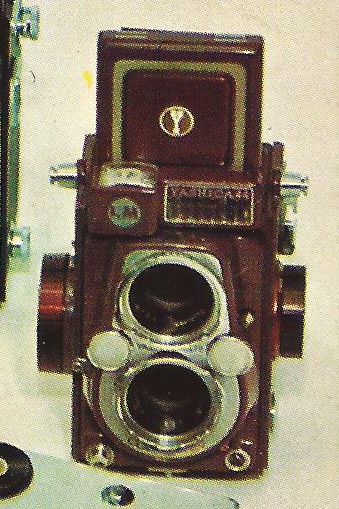
It is certainly doesn't look dark enough to be Burgundy (dark brown). The brochure includes a Yashica Minister D 35 mm rangefinder camera (not shown, on an inside page) which was released in either late 1963, or more probably, early 1964. The 44LM itself is from August 1959 or earlier - after then, the background for the hood logo changed to blue. In any case, only grey examples appear in my database from April 1960 and the last 44LM with the “white” control wheels is from June 1960. So at the time of the brochure, neither Rose Brown nor any other colour than Charcoal Gray was available.
Of the 286 Yashica 44LM cameras in my database, the last 189 are all Charcoal Gray. There are 42 earlier Charcoal Gray most of which are Japanese market versions without red windows. There are 6 Burgundy cameras all from the first couple of months of production, the remaining cameras are black.
Introduction of Blue Hood Logos
The first 66 model to receive the blue hood logo was the Yashica D in October 1959. The Yashica A and Yashica-Mat had to wait until the beginning of 1960. However, the first models of any format to change over to the blue hood logo were the 44A and 44LM but the blue logo was initially limited to the early black versions (plus the odd Pastel Blue 44A) and then they too changed to gold for a few weeks but with several thousand cameras produced! Both the 44A and 44LM fully changed over from the gold logo to blue in the middle of August 1959, i.e. earlier than any 66 model. However, the first black 44LMs which arrived in the first month of production (May 1959) already had the blue logos. Some earlier black and Pastel Blue 44A cameras (the earliest black in April 1959) also had blue logos but the implementation seems more sparse and random than the early black 44LMs and gold logos on the same colours from the same period predominate whilst there are no early black 44LMs with the gold logo. At the beginning of August, the logos on the black 44LMs changed to gold to match the Charcoal Gray examples (Burgundy was already discontinued) and black 44A cameras (other colours were also discontinued and Charcoal Gray was yet to arrive). However, by mid-August, all 44A and 44LM examples adopted the blue logo.
Control Wheels
All the control wheels are silver but there are three distinct types of covers or inserts. The differences are subtle. The earlier ones that appear on all the brown and black cameras and early grey cameras up to serial number 651xxx reflect white in photos. The wheel inserts on most of the grey examples are the more domed appearing dull silver also found on 66 models. Very late cameras from FL 5010xxx onward (January 1965) received the flatter shiny silver wheel inserts that appeared on 66 models from the middle of 1965. These have a reflection reminiscent of a spinning aeroplane propeller. Note that the inserts are glued on and quite a few 44LM examples have lost theirs from both sides. Underneath is shiny and in photos it is easy to mistake them for shiny control wheel trim. The give-away is the small hole in the centre of the wheel.
First type control wheels, second type dull silver control wheels and late third type shiny silver wheels. Fourth example is camera with dull silver control wheels with one cover/insert missing:
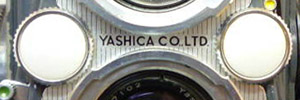
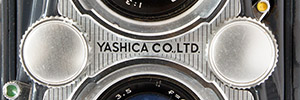
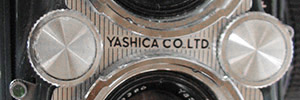

(Images 1, 3 and 4 detail from larger web images)
Accessory Shoes
Until a second was identified by contributor Leigh Harris in 2019, I thought that there was only one type of accessory shoe but there are actually two. In the process of coming to grips with that news, I also discovered that Yashica had two ways of placing the <EP> mark (background here).
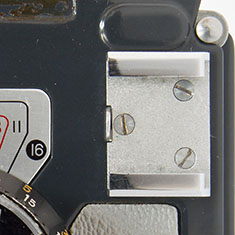
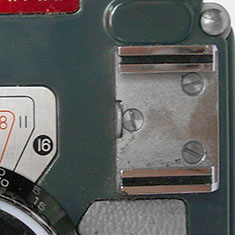
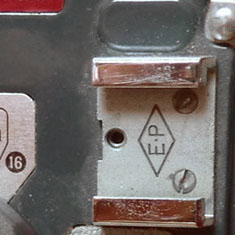
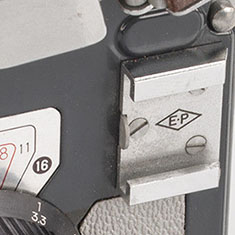
(Image 2 courtesy of Leigh Harris, images 3 and 4 detail from larger web images)
The first shoe is the “common” type. The second shoe has a black painted square section groove top and bottom. It seemed to appear on approximately 50% of cameras, both export and domestic types until about July 1959 (397xxxx numbers, third month of production), however, two domestic types from 1960 also have them.
The choice of <EP> orientation seems arbitrary. The pattern from earliest to latest is: vertical-horizontal-horizontal-vertical-vertical-horizontal-horizontal-horizontal. They are spread reasonably evenly from 1960 to 1964 and body and lens serial numbers are consistent with their placement in the database.
Labels
As well as glued on control wheel trim which is a little suspect, the Yashica 44LM has three glued on labels of which one or more are often missing. The most obvious is the red “MADE IN JAPAN” label on the focusing knob side. There are also labels for the M/X switch and self-timer. The only missing one that is annoying, and possibly dangerous, in use is the M/X label. However, the one that most detracts from appearance is the “MADE IN JAPAN” label on the side but this happens so often, it maybe hard to avoid. Earlier cameras are worse affected than later ones. Worries some, not others.
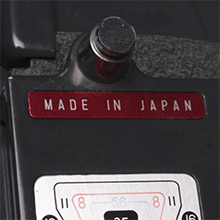
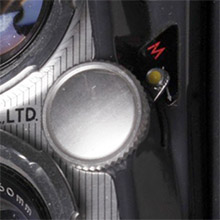
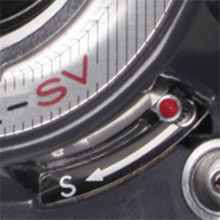
(All three, detail from larger web images)
Considering the large number of variations introduced with all the 44 models, it should be no shock to learn that there are two versions of the “MADE IN JAPAN” label. However, when contributor Leigh Harris mentioned it to me in 2019, I was surprised that I hadn't noticed it earlier:
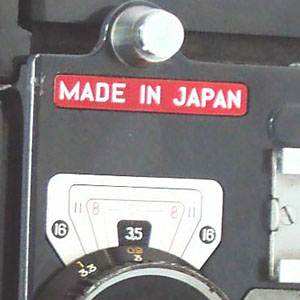
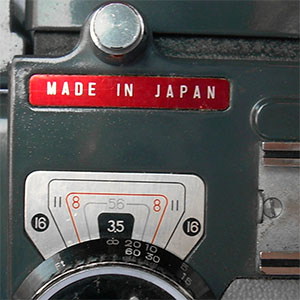 (Image 1 detail from larger web image, image 2 courtesy of Leigh Harris)
(Image 1 detail from larger web image, image 2 courtesy of Leigh Harris)
Early Japanese market Charcoal Gray example on the left, later Charcoal Gray example on the right. The change from the large font to smaller occurred between cameras 3961xxx and 3964xxx (i.e., in June 1959 already, second month of production).
Then Leigh told me about the two different M/X labels:
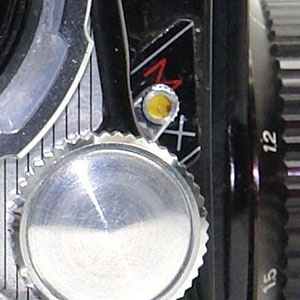
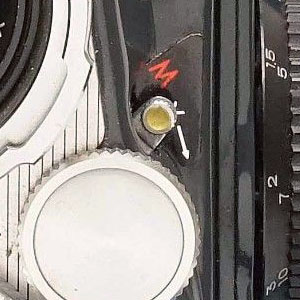 (Detail from larger web images)
(Detail from larger web images)
The changeover occurred in September 1960. The version on the left with the lines to the left of the “M” and to the right of the “X” is the initial type with the last example in my database being camera 1661002xx. The first example of the version on the right with the arrow below the “X” is camera 1661004xx. (Note, the left example has dull silver control wheels and although hard to believe, the right example is a late model with shiny silver control wheels, not white - other photos confirm it and the camera is now owned by Leigh. It's all about the lighting.)
Neck Strap
The 44LM features unique mounting posts for the quick release neck strap. The neck strap features a clip-on metal clip which can rotate around the post and a hinge at the leather attachment point to allow sideways movement:


(Detail from larger web images)
Trim Changes - By Serial Number
The first Yashica 44LM in my database is the camera in the user manual, 3930009 with taking lens 200022. The first production camera is 3950xxx with taking lens 202xxx and viewing lens 202xxx. It is one of the grey Japanese market types without red window. It has a gold focusing hood logo. The next example has taking lens number 204xxx and is Burgundy with a gold logo on the hood. The next two cameras are black followed by five Charcoal Gray examples without the red window: camera with taking lens 466xxx, two cameras 3960xxx with taking lenses 471xxx, camera 3961xxx with taking lens 467xxx and another camera with taking lens 467xxx. Burgundy camera 3964xxx, two black cameras 3964xxx and Burgundy 3970xxx (taking lens 202xxx) follow. The lens numbers are all over the place with mixed series seeming to begin with 202xxx, 467xxx and 504xxx. The serial numbers rise to 3984xxx and include another four Charcoal Gray types without the red window. Camera 3983xxx is the first of only two early Charcoal Gray examples with the red window. The changeover to consistently blue hood logos occurred at around 3984xxx
Then there are seven cameras in the eight digit 39100xxx range, five Charcoal Grey without the red window and two black examples with.
There are four cameras in the new 7 digit series 4110xxx to 4111xxx followed by thirty one in the 6 digit series ranging from 610xxx to 670xxx. Between 620xxx and 630xxx, the focus distance scales changed to dual scale. There is a mix between those numbers including no red window example 621xxx. Camera 641xxx is the first of the continuous block of Charcoal Gray cameras. Camera 650xxx is the last with no red window (there is also 670xxx but I suspect a replaced meter) and camera 660xxx is the first with the dull silver control wheels. Then there are nineteen nine digit serial numbers in the range 166090xxx to 166110xxx.
The final block of 91 cameras have an “FL” prefix and seven digits and range from FL 1020xxx to FL 6120xxx, again with no second digit from the left higher than “1” (no 2nd or third digit together higher than “12”). At around FL 2080xxx, the external pressure plate screws disappear from the back (there are a couple of exceptions with FL 2081xxx numbers). Thirteen of the last fourteen cameras with lens caps have plastic lens caps for the first time. FL 3070xxx is the first of these. Fourteen of the last sixteen cameras starting with FL 5010xxx have the new shiny control wheels. Three cameras with serial numbers FL 5040xxx to FL 5070xxx plus one other with only lens numbers visible have the wide “Y” hood logo. Two other cameras with FL 5070xxx serial numbers still have the earlier logo. Starting with the late example below, there are still higher numbers to come but these are almost certainly repaired items.
Late Example?
Until more recently, the camera below was the only one with a wide “Y” hood logo found. There are now at least four genuine ones plus one seen for sale in the B&H Photo Video store used camera department. The serial number on the meter housing is FL 5090129 suggesting September 1965. Even though there are other numbers as high as FL 5070xxx (in other words, July), I think that a September date is too late. In any case, I can now categorically say that the rest of the camera is from 1961 and the hood and meter are replacement parts, probably after a fall, and the meter at least, probably from Yashica's stores system. As noted in “Trim Changes - By Serial Number” and at the top of the 44LM section, a genuine one should have shiny control wheels (this one's are the second dull silver type). The camera back should not have visible screws - this one doesn't but I know that in a mix-up, the seller swapped the camera's back with another. The dual scale focusing knob has the feet scale in white and the metre scale in yellow. The scale became all-white in 1961 or 1962. Finally, the lens numbers, 740892 and 741377, typically belong to examples from mid-1961.
.jpg)
.jpg)
(This camera also appears at the beginning of the Yashica 44LM section.)
The focusing hood has one of the Japanese Camera Industry Institute (JCII) oval gold “PASSED” quality stickers common on Japanese export cameras from the mid 1960s to late 1980s. How it got there is a mystery but I wouldn't expect to find it on a spare part so maybe that is from another camera? The sticker has the number “53”. There is plenty of discussion on the net about these stickers but not too much referenced fact. One recurring claim about these numbers is that the first digit is the year of the decade and the second digit is the month of the year that an example of that batch of product was tested - a camera with that sticker might be made a long time afterwards. In this case, the sticker date would be March 1965 which is getting close to the new logo style first appearing. Understand though, I am just repeating net gossip about the stickers which happens to fit the circumstances.
Repaired Cameras with Higher Serial Numbers
In The Yashica Spares System Theory - the Impact on Serial Numbers, I postulated that Yashica spare parts marked with camera serial numbers, such as nameplates, focusing hoods and exposure meters, feature higher numbers than normal production examples. The evidence, I think, is compelling.
Most probably, the first 44LM in the “repair” series is the camera above, FL 5090129 (it is certainly repaired but the September date could feasibly have belonged to another production camera, but I think unlikely). Then there are two with FL 6111xxx numbers and one with FL 6120xxx i.e., from November and December 1966. These numbers are certainly too late for production cameras. Two of the three have visible screws in the back (one is unknown), two have dull silver control wheels and one has the first type, all three have the narrow “Y” on a blue background focusing hood logo and two of the three have dual scale focusing knobs with metres in yellow. Lens numbers match cameras from the 1960 to 1961 period.
Lens Caps & Ever-ready Cases
(See also Lens Caps, Cases & Boxes page.)
The majority of lens caps, are hinged cast alloy, the same as for the Yashica 44. I have found matching Burgundy, black and Charcoal Gray examples. Thirteen of the last fourteen lens caps found in my database are dark grey plastic (consistent with the change over on 66 models).
Camera cases are either grey or brown and similar to the Yashica 44A, brown replaced grey just before prefixed serial numbers were introduced, the first camera with a brown case being 650xxx, by which time all cameras found are grey. There is one brown case amongst the greys and two grey cases amongst the brown, all three likely to be the result of 50 years of mixing and matching - a pretty good result.
Nine of the last twelve ever ready cases received a new narrow “Y” logo. Instead of the old white on gold flat logo, the new logo is 3 dimensional with raised “Y” and circular border in shiny gold metal on a creamy white enamel background. The first camera with this case is a FL 4010xxx. Two cameras with the new wide “Y” focusing hood logo have turned up with companion cases with the wide “Y” logo as well. Except for the lettering style, the two late logos are very similar:
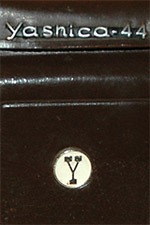
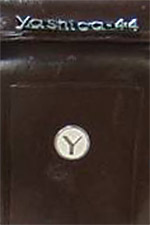
(Detail from larger web images of Yashica 44LM cases)
Yashica Auto 44
Probable release date |
mid 1959 |
Probable end date |
mid 1959 |
Lens |
Filter Mounts |
Frame Counter |
Shutter |
|||
Make/Type |
Sync |
S/Timer |
Speeds |
|||
| Yashinon |
Bay 1 |
Hybrid |
Copal SV |
M/X |
Yes |
B,1-1/500 |
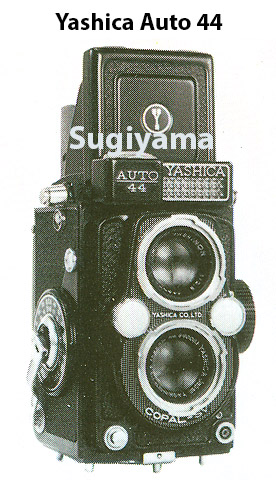

(Left image from “Collector’s Guide to Japanese Cameras” by Koichi Sugiyama, right image of a typical early black 44LM courtesy of Tom Heckhaus)
A mythical camera yet Sugiyama has a photo and claims that it is far less rare than the Yashica E which is relatively easy to find - I don't comprehend that at all, I have only found one reference to another sighting or a sale, see below, and no mention in Yashica advertising or other documentation. Sugiyama dates it from 1959. Note, the photo is not of some random collection camera, it is credited as supplied by Yashica - that is significant. Camera-wiki.org speculates that it may be a variation of the 44LM available in some markets (in notes, the author admits that is a guess) but that is clearly wrong - it is much more than that. The black and white photo shows a dark camera, likely all black to fit its serious intent. The panel surrounding the Bay 1 mounts is dark patterned (not black) and has either white or silver text. Close inspection shows a more or less typical Yashica 44LM appearance but with the following key differences:
- It has the earlier Yashica 44 crank instead of the 44LM knob wind but uniquely, the circular panel under the crank has film speed conversion scales similar to the Yashica Mat-LM.
- There is no lever to cock the shutter, so it must be cocked with the crank back-wind, as on the 66 models thus truly befitting its “Auto” title.
- The film counter reset button is higher up, under the strap holder lug, but being fitted, the film start is still most probably set by red window, unlike early Japanese market 44LMs.
- Unlike the 44LM, the front focusing panel has leatherette inserts and this is designed differently to allow them to neatly fit in.
Sugiyama's book contains the brief description, “Yashinon - f2.8, 60mm”. The photo seems to confirm that the viewing lens is f/2.8. However, Sugiyama always quotes the taking lens aperture. The aperture cannot be discerned on the taking lens, however, it is clearly special in that there is a lot more text than on other lenses including the Yashinons on the 44LM. The word “Yashica” is clearly visible (the only instance on a TLR lens that I am aware of) and I think that “Yashinon” is still there too.
I doubt that such significant changes were made late in the 44 series life when the end of the 127 format must have been obvious. Sugiyama claims 1959 so it would have to have been a parallel release with the 44LM, or earlier. The control wheels appear to be the first white 44LM type. The focusing hood logo background looks dark so may be blue rather than gold but that still fits with early black 44LM examples, see here, the Auto may be where the blue background logo originated.
According to a knowledgeable Australian collector, a rough one did come up on eBay in about 2003. This seems to be borne out by the Collectiblend price guide which refers to a sale on 28 February 2003.
My own guess is that the Auto 44 was a prototype, noting that the only known photo was sourced from Yashica. Maybe even the prototype for the 44LM rather than of an unreleased model. It may have reached a pre-production phase and the supposed sale in 2003 could have been of an example that had escaped into the wild, a bit like the Yashica Hi-Mec probably. As the Yashica 44 was already considered expensive for its features, the addition of f/2.8 lenses and auto shutter cocking may have been too much to bear. This was at a time when demand for 66 models was falling and the brief 127 super-slide bubble was fading. On the other hand, the large film winding knob on the 44LM, with perhaps more convenient exposure scales, may have been considered a more modern solution for a small camera - it had worked for the Baby Rollei.
.jpg)
.jpg)

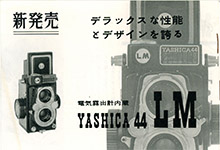
.jpg)
